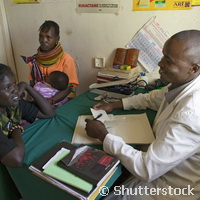Predicting climate-change-related disease in Africa
It is common knowledge that climate change particularly affects developing countries, but its effects on health are still very hard to predict. In a joint effort to bridge this gap, the QWECI project set out to assist medical practitioners and public health decision-makers in allocating resources and implementing preventative measures ahead of disease epidemics. Whilst climate-change predictions depend on many variables, making forecasting a real conundrum for scientists across the world, the impact of a changing weather on human health is even more uncertain. It is now largely accepted that global warming increases the concentrations of air and water pollutants, and affects the seasonality of certain epidemic diseases. But how can such changes be predicted, especially in Africa where local knowledge is hardly used in forecasting methods? The QWECI project brought together researchers from 13 European and African research institutes to integrate data from climate-modelling and disease-forecasting systems. The project focused on climate and disease in Senegal, Ghana and Malawi and aimed to give decision-makers the necessary time to deploy intervention methods and help prevent large-scale spread of diseases such as malaria and Rift Valley fever. It is expected to help predict the likelihood of a malaria epidemic four to six months in advance. Andy Morse, principal project investigator and climatologist at the UK's University of Liverpool, told research eu* results magazine about the project's outcomes and their expected impact on Africa's capacity to predict and counter health-related issues caused by climate change. What were the main objectives of the project? The overall objective of QWECI was to combine state-of-the-art climate models, weather-dependent infection-control data for key African diseases, and local knowledge about population behaviour, disease, vectors and transmission patterns. The outputs could thus generate maps of infection risk appropriate to the decision-making of health professionals on the ground and the policy-making of governments in susceptible countries. What was new or innovative about how you addressed climate change impact in developing countries? QWECI's value-added resides in the integration of the most reliable climate-based prediction models with models of climate controls on disease risk variables for 'vector-borne diseases' (VBDs) on medium and long timescales. This results in unique and meaningful information which can be rapidly conveyed to end-users and allows for the quantification and prediction of the impact of climate and weather on health in Africa. What first drew you to research in this area? Back in the late 1990s, the need for better prediction and containment of climate-change-related diseases became obvious in the developing world, especially in Africa. There was a clear lack of use of climate-model data sets for impact studies, and I wanted to contribute to their more widespread use. What difficulties did you encounter and how did you solve them? It is difficult running a project across such a large area, which is so far from Europe, while maintaining the uptake of the model outputs by local users. We overcame this by getting key regional partners and users on-board, through the organisation of national and local level workshops. What are the concrete results from the project? We have taken malaria modelling driven by seasonal-scale ensemble prediction systems to the operational cusp. The region's capacity to use and interact with malaria-modelling technologies was also developed: we used local parameter settings from field studies in the region, and methods including long-range WiFi to communicate the results to local users. Through international workshops and visits, QWECI helped to share the knowledge of local health practitioners in isolated communities and state-of-the-art modelling expertise. It also enabled long-standing collaboration between different institutes, countries, scientific communities and health agents across Africa and Europe, which should all facilitate future joint efforts. How do you expect QWECI to improve people's lives in developing countries? If we can get the QWECI malaria models fully operational within a seasonal ensemble prediction system, we will have reached an effective stage in what could develop into a pan-African early-warning system. What are the next topics for your research? In the future, we would like to develop similar systems for other climate-driven vector-borne diseases, including Rift Valley fever which primarily affects animals but can cause severe disease in humans as well. The project was coordinated by the University of Liverpool in the United Kingdom.For more information, please visit: QWECI http://www.liv.ac.uk/qweci/ Project factsheet
Countries
United Kingdom



